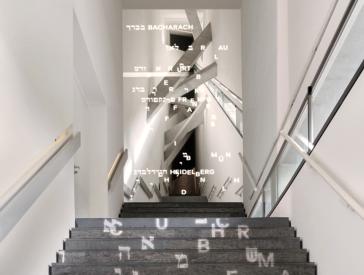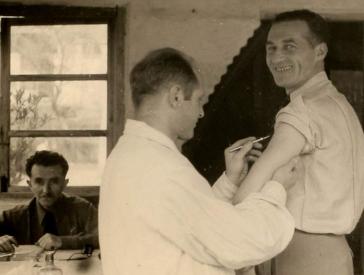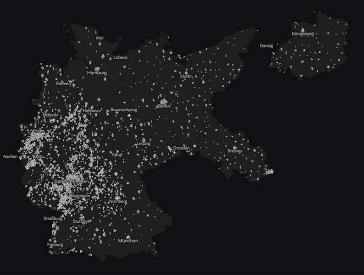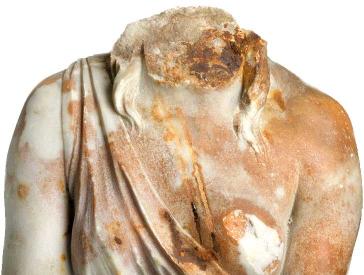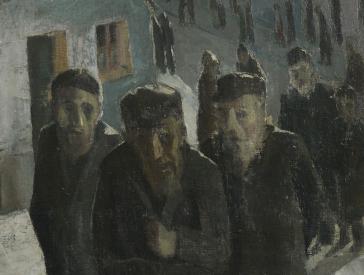International Museum Day: 16 May 2021
Virtually Explore the Jewish Museum Berlin and Its Subjects

International Museum Day 2021 is taking place on 16 May with the theme “The Future of Museums: Recover and Reimagine.” We are taking the opportunity to share with you the multiplicity of our (digital) programming. Especially during the pandemic, many new digital formats have been created at the Jewish Museum Berlin. We’ve gathered a selection of them for you here on this curated page. These are supplemented by recorded conversations with eyewitnesses to history, which we sincerely recommend.
Our Stories: Eight Objects and Their Stories
From a boxing trophy, which the owner rediscovered in the ruins of his house, to the painting of an emancipated 19th century woman in her living room, to a child’s drawing of a father who emigrated from the Soviet Union to Germany... In the video series “Our Stories,” eight curators from the new core exhibition each tell the story of one object. Who are or were its owners? How did the object become part of the museum’s collection?
Our Stories: The Damaged Torah Wimpel with Aubrey Pomerance
The Catastrophe epoch room of the Jewish Museum Berlin’s new core exhibition includes an object that wears its tragic history on its sleeve: a Torah wimpel, or cloth binder, which was damaged during the destruction of the Worms Synagogue in the November pogroms of 1930 and exhibits conspicuous signs of fire. Archive director Aubrey Pomerance tells the object’s story and explains how it became part of the museum’s new core exhibition.
Jewish Museum Berlin, 2023
Our Stories: Alfred Benjmain with Ulrike Neuwirth
In 1942, a man’s body was discovered in the French Alps. In his coat pocket: a wallet containing photos and documents. Based on these, the man was the 31-year-old Alfred Benjamin of Germany. He had arrived France in 1934 on assignment for the now-banned German Communist Party and lived in Paris. Together with his wife Dora Schall, whom he had met in the Netherlands, he fought the Nazis as a member of the Resistance. Archivist Ulrike Neuwirth tells the couple’s story and explains how the wallet came to be in the Jewish Museum Berlin’s collection.
Jewish Museum Berlin, 2023
Our Stories: Entebee with Cilly Kugelmann
A postcard-sized work by the artist Boris Lurie: it features a white star on a yellow background, with the words “Judenknax,” “Fasanenstrasse – Synagoge,” and “Entebee”—what events does the work of art refer to? Cilly Kugelmann, head curator of the new core exhibition, tells the story of this small item in the exhibition and explains what makes it so valuable to the JMB collection.
Jewish Museum Berlin, 2020
Our Stories: The Ring with Miriam Goldmann
A tiny pewter ring with a menorah on it—it was found just twenty years ago in Kaiseraugst, Switzerland, but it dates to the 4th century. How did it arrive at its place of discovery and what does it tell us about the interwoven nature of Jewish and Christian culture? Miriam Goldmann, a curator for the core exhibition, tells the story of the oldest item in the new JMB core exhibition and explains why it is so valuable to the museum.
Jewish Museum Berlin, 2020
Our Stories: The Boxing Trophy with Leonore Maier
A small boxer made of bronze standing on a marble pedestal. His left arm is glued on, but its hand is missing—what does this object tell us about its owner and his life story? Leonore Maier, a curator of the new core exhibition, tells the moving story of Günter Loewinski, who survived the war in Berlin and rediscovered his boxing trophy in the ruins of his apartment building.
Jewish Museum Berlin, 2020
Our Stories: The Sweater with Tamar Lewinsky
A green and white knitted sweater and a photo of two sisters taken in a DP camp, in which one of them is wearing the sweater—what does this sweater tell us about the postwar era in Germany? Tamar Lewinsky, curator for contemporary history and for the new core exhibition of the Jewish Museum Berlin, tells a story of escape and persecution, new beginnings and memory.
Jewish Museum Berlin, 2020
Our Stories: Migration Objects with Theresia Ziehe
A compasses case, a child's painting, a kosher pan—what do these exhibition objects tell us about the migration experiences of Jews who came to Germany from the former Soviet Union? Theresia Ziehe, a curator of the new core exhibition at the Jewish Museum Berlin, talks about a daughter's longing gaze backwards and a woman's sense of connection to religious tradition in her family.
Jewish Museum Berlin, 2020
Our Stories: A Family Album with Aubrey Pomerance
Emigrate or wait and endure? In December 1936, to say farewell to his friends Erst and Margot Rosenthal, Bruno Heidenheim gave them an album: “Farewell, farewell, think of us oft, we'll send you our well-wishing thoughts. Happiness awaits across the sea, but saying goodbye to you isn't easy.”
Written and illustrated with an eye for detail, Heidenheim wanted to give his friends an “etiquette guide”
for America. Aubrey Pomerance, archive director and curator of the new core exhibition, talks about this testimony to a close friendship and two diverging life paths.
Jewish Museum Berlin, 2020
Our Stories: Fanny Lewald with Inka Bertz
A glimpse into a 19th-century work and living space : the cozy apartment belongs to the writer Fanny Lewald, who held a successful Berlin salon in her time. What does the image tell us about the inconspicuous-looking woman seated at the desk? Inka Bertz, director of the JMB collections and curator of the new core exhibition, tells the story of a luminary who fought for the emancipation of women and Jewish people.
Jewish Museum Berlin, 2020
Our Stories: The Flamenco Dress with Monika Flores
A white, purple, and pink flamenco dress, decorated with ribbons and heaped with ruffles. At first glance, there's nothing about this dress that one would generally associate with Jewishness. But it belonged to a Jewish person: Sylvin Rubinstein bought it, added certain details, and later wore it himself. Monika Flores, curator for the new core exhibition, tells the story of a distraught man who grieves his twin sister's death in his own way. Flores describes a Jewish object that reveals its identity upon close examination.
Jewish Museum Berlin, 2020
A Virtual Exploration with the JMB App
As well as serving as a guide and companion during a physical visit to the museum, the JMB App also enables a virtual visit. Through original recordings featuring the voices of figures such as Daniel Libeskind and Yael Bartana, the app captures a variety of perspectives, including that of the blind museum guide and musician Jonas Hauer, who describes how blind visitors can perceive the spaces of the museum.
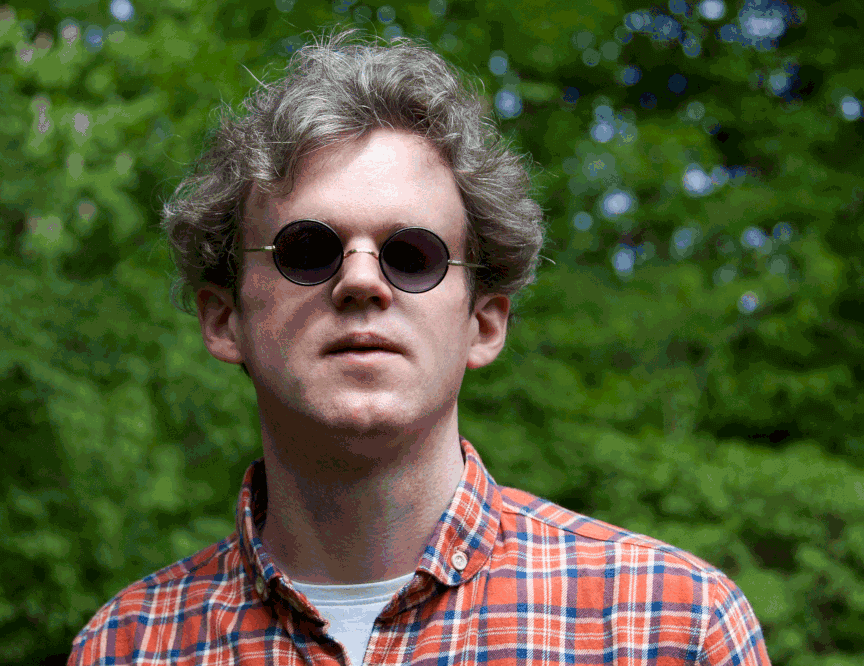 X
X
In the JMB app, our museum guide Jonas Hauer, who is blind, explains how he perceives the spaces in the museum; Foto: Jonas Hauer.
The axes “Something is coming towards me”
Read along: The axes “Something is coming towards me”
Moving through the axes has its snags. The distance between the floors and ceilings change and the walls are not at right angles to the floor.
What is rather unsettling to sighted visitors makes for a very special spacial experience for blind and visually impaired people. The blind museum guide and pianist Jonas Hauer will now tell us about his experience of the space:
Jonas Hauer: “The floors in the axes rise up, so where you start is the lowest point and the end – before you get to the Holocaust Tower or the Garden of Exile – is the highest point. Acoustically, the main effect is that I feel like something is coming towards me. The axes get narrower, they become more oppressive.
The horizontal structure stays the same, it doesn’t change at all. It’s actually very interesting that it doesn’t change. On one level, the horizontal level, it stays the same, no matter where we are – at the beginning or at the end. But the height changes.
I have the feeling that something is coming towards me from above, not from the side, but from above. And that’s interesting, because acoustically, it’s a totally different effect … It could get narrower from all sides, like a funnel – the walls could converge too, but they don’t. It’s only the ceiling that comes towards me.”

Garden of Exile “The most manageable place”
Read along: Garden of Exile “The most manageable place”
Jonas Hauer: “The Garden of Exile, yes, that was always the point where sighted and non-sighted visitors were actually separated. I know that for sighted visitors, it’s a very confusing place. For blind visitors, however, it’s very manageable. That’s because sighted people obviously orient themselves with their vision and because everything is tilted, at some point you don’t know what is actually at an angle – the columns? The floor? You? It’s very hard to orientate yourself.
For me, the structure is fantastic, because the columns are all the same size and have the same space between them. The garden has a square ground plan and it’s tilted – even tilted again on itself. The lowest point is at one of the corners, which is great for me because I know that when I want to leave, I just have to head downwards. The one thing that’s a bit disturbing is the ground. It’s very uneven. If that was smooth, it would be the perfect structure for me.
For me it was always a beautiful place. I could always relax in this garden. For sighted people it’s the opposite – the other extreme. It’s great because it illuminates exile in a completely different way. I mean I don’t really know about exile myself, but I can imagine that things like this can happen in exile. That through a new orientation, perhaps, you experience a new stability that you don’t perceive in the place you’re from or in your everyday life. For other people looking from outside, or maybe experiencing it with another sense, it’s much easier to perceive.”
Voided Void „Cold, desolate acoustic“
Read along: Voided Void „Cold, desolate acoustic“
Jonas Hauer: “This Void, the Holocaust Tower, doesn’t just work on an architectural level of course, or on the level of what can be seen, but it works on a haptic level. I enter it and it is a totally different environment.
This tower sounds like … a large industrial space. It’s just not so big. It’s almost like a factory that’s had its walls pushed in, so I feel somehow crushed by them too. You can hear this quite clearly acoustically.
I hear the concrete. And because it has this one sharp corner … when I stand in this corner, I hear what it does to me. It’s a very strange, cold, desolate acoustic. I’d invite visitors to come in and maybe stand in different places and do this …”
Sound: he snaps fingers
Jonas Hauer: “… and hear what happens. What comes back? What comes back to me from different points? It’s very different when I stand in the corner from when I stand in the middle.
There’s a particular spot in this tower – visitors are welcome to try and find it – where I notice suddenly something coming back to me from all sides. I really feel like I’m standing at the focal point of a lens, right in the center. I send something out and it rushes straight back at me from all sides – it rushes at me from above, from below and from all sides. The place is really, really remarkable.”
Shalekhet „Echo“
Read along: Shalekhet „Echo“
This space is not just visually impressive, it has an amazing acoustic as well. Try closing your eyes. Jonas Hauer describes the effect this space can have on people who are vision impaired …
Jonas Hauer: “When we stand here, at the entrance to the installation Fallen Leaves, we hear that the acoustics are very interesting. There’s a lot of reverberation. If we stand here by this ... sort of boundary wall we can look into the installation. It’s a very elongated space and there’s this phenomenon of a long space sloping upwards … clearly there’s concrete, but what we hear, what’s bouncing back from the walls … that’s different again. There’s something industrial about it. Because there’s so much reverberation, though, it also seems to me to have something ... almost sacred to it. Really, so much – eight seconds at least. And if there are visitors moving about in the installation, then, of course, we get this acoustic effect of metal as well.”
You’re very welcome to walk forward a few steps into the installation space. Be careful though, the floor is uneven. The metal plates will move when you walk on them.
If you would like to look around the core exhibition, the architecture, or the gardens using the app, you can find the download links on the JMB App page.
Four Questions, Many Answers
The new core exhibition recounts Jewish history and culture from its beginnings up to the immediate present. At the end of their tour of the exhibition, visitors encounter the video installation Mesubin (The Gathered) by the artists Yael Reuveny and Clemens Walter. In a concluding chorus of a sort, many Jews across 21 separate screens discuss their experiences of Jewishness in Germany. Intrigued? The following four short films speak to the polyphony of Jewish life today.
Eyewitnesses to History
The series Eyewitnesses to History is almost as old (or young) as the Jewish Museum Berlin. Shortly after the museum opened twenty years ago, the Head of the Archive, Aubrey Pomerance, began conducting conversations with eyewitnesses to history. Their stories and memories give testimony to the Nazi period and represent a wide range of survival experiences. You can see the whole playlist in our media library (in German).
Eyewitness Talk
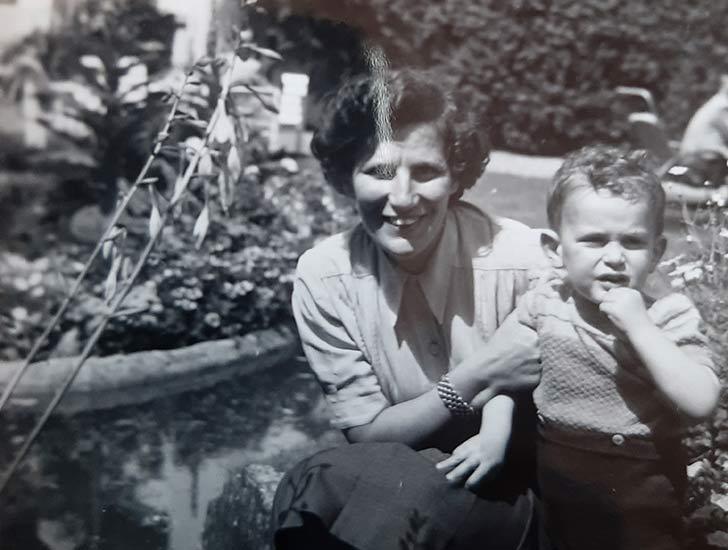
Eyewitness talk with Jack Weil, Video recording from 10 Mar 2025 (in German)
More information on the event
Eyewitness talk with Kurt Salomon Maier, recorded on 28 Oct 2024 (in German)
More information on the event
Herbert Zwartz: Hidden in Enschede, video recording from 16 Apr 2024
More information on the event (in German, with German subtitles)
Eyewitness talk with Ruth Weiss, recorded on 20 Sep 2022 (in German, with English and German subtitles)
More information on the event
Eyewitness talk with Harry Raymon, recorded on 28 Jan 2022 (in German)
More information on the event
Eyewitness talk with Eva Schloss, recorded on 21 Jan 2021 (in German, with English and German subtitles)
More information on the event
Eyewitness talk with Peter Schaul, recorded on 9 Nov 2020 (in German)
More information on the event
Eyewitness talk with Zvi Aviram, recorded on 16 Sep 2019 (in German)
More information on the event
Eyewitness talk with Sally Perel, recorded on 12 Jun 2019 (in German)
More information on the event
Eyewitness talk with Peter Neuhof, recorded on 3 Dec 2019 (in German)
More information on the event
Eyewitness talk with Hanni Levy, recorded on 25 Jun 2018 (in German)
More information on the event
Eyewitness talk with Anita Lasker Wallfisch, recorded on 28 May 2018 (in German)
More information on the event
Eyewitness talk with Margot Friedländer, recorded on 9 Apr 2018 (in German)
More information on the event
Eyewitness talk with Walter Frankenstein, recorded on 31 Jan 2018 (in German)
More information on the event
Eyewitness talk with Horst Selbiger, recorded on 11 Jan 2018 (in German)
More information on the event
Eyewitness talk with Kurt Roberg, recorded on 4 Dec 2017 (in German)
More information on the event
Eyewitness talk with Henry Wuga, recorded on 23 Oct 2017 (in German)
More information on the event
Eyewitness talk with Marko Feingold, recorded on 10 Oct 2016 (in German)
More information on the event
Eyewitness talk with Renate Lasker-Harpprecht and Anita Lasker Wallfisch, recorded on 1 Mar 2016 (in German)
More information on the event
Discover Sites of Jewish Life in Germany
The interactive map Jewish Places invites you to discover and explore sites of Jewish life in Germany on your own doorstep and share them with others on the online platform. Beyond that, the project – which won the 2020 Kulturlichter Prize – also facilitates workshops for schoolchildren who research Jewish history in their own neighborhoods and situate it geographically using the interactive map.
For example, high school students from the Goethe Gymnasium of Bad Ems put together the walking tour of Bad Ems (in German) together with their teacher.
With Jewish Places, you can find more urban walks or learn about the lives of notable Jewish figures while on the move. For example, visit the landmarks of Felice Schragenheim’s life in Berlin (in German).
